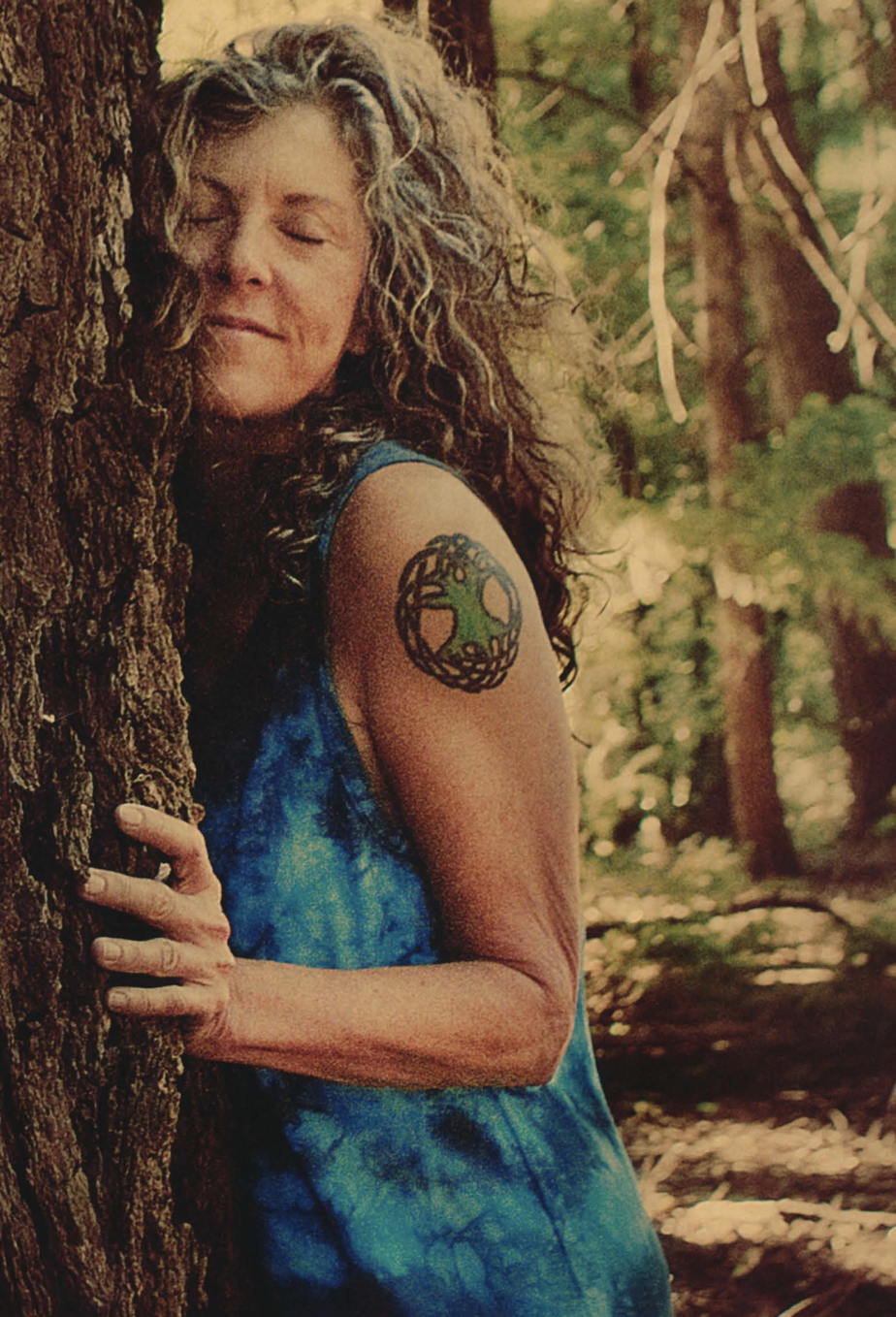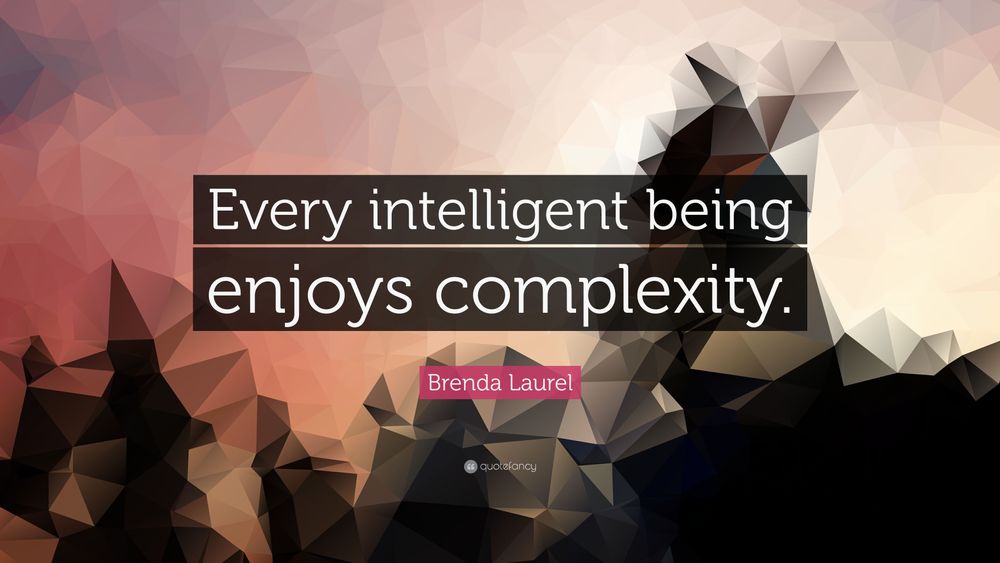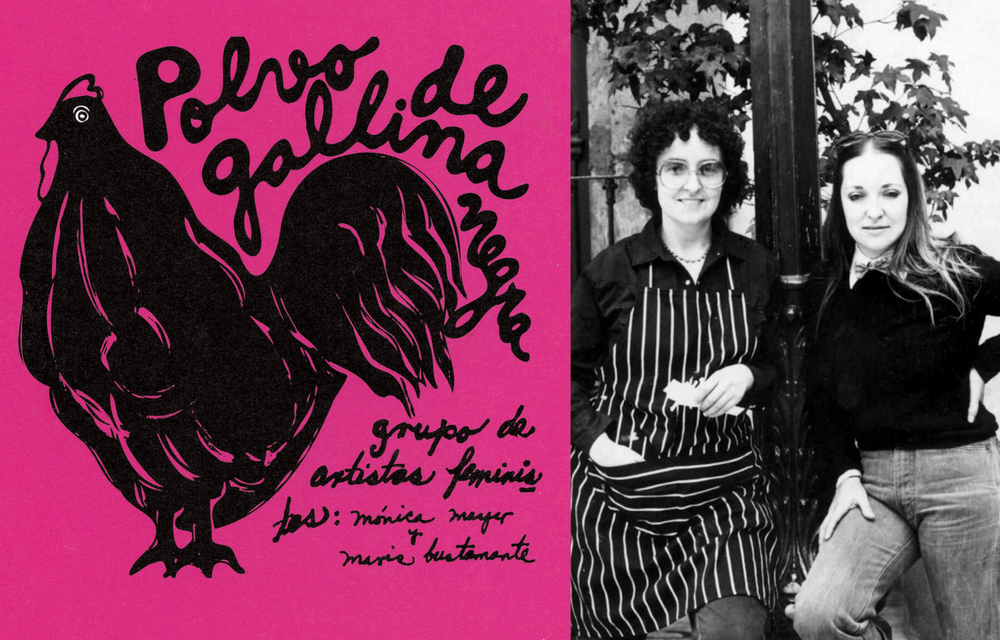In this episode, we strap on our VR goggles and take a look at both kinds of virtual reality – the one you make with technology, and the one you make with magic. By the keystrokes of visionary techno-pagan and software pioneer, Brenda Laurel, we learn to bridge the gap between computer, theatre, nature, and reality.

Transcript
As podcasting witches we find our people on the instagrams and in facebook groups, we are lovers of forests and lakes AND city-scapes, ukuleles and wawa pedals. Digital AND analogue, and these tiny super computers we get to carry around with us all the time. So we wanted to find a techno pagan to bridge the gap, and maybe question if the gap exists at all. A cyber witch to round out our first season of Missing Witches, and remind us that the word technology at its root, means "science of craft".
Maybe like me the term technopagan makes you picture Willow from Buffy the Vampire Slayer - flying past firewalls to dip deep in archives, her black eyes crackling and cd-roms at the ready. Late 90s writing and representations about techopagans offer good clues about what the early internet meant to a witch stretching her powers out into the gender-fluid, world-making possibilities of those secret codes.
But as much as Willow is life goals, we wanted to find someone real, and if possible a witch who bridged the cyber witch worlds of then - CD ROMS and MUDs and wysiwyg - and now. A new wave techo pagan playing with the exponentially empowered tools of today. And after falling down a rabbit hole of Wikipedia and googling and links in blogs, we found a woman who synchronized witchcraft and technology to pioneer the magical landscape of virtual reality: Brenda Laurel.
She pops up in a 1995 article from Wired, titled simply: Technopagans
Today, in the silicon crucible of computer culture, digital denizens are once again building bridges between logic and fantasy, math and myth, the inner and the outer worlds. Technopagans, for all their New Age kitsch and bohemian brouhaha, are taking the spiritual potential of this postmodern fusion seriously. As VR designer Brenda Laurel put it in an in e-mail interview, "Pagan spirituality on the Net combines the decentralizing force that characterizes the current stage in human development, the revitalizing power of spiritual practice, and the evolutionary potential of technology. Revitalizing our use of technology through spiritual practice is an excellent way to create more of those evolutionary contexts and to unleash the alchemical power of it all." https://www.wired.com/1995/07/technopagans/
Brenda Laurel’s game company, Purple Moon, directed at girls - among the very first to recognize this part of humanity online, telling stories of girls in the forest, linked with magic- and her writing about gaia and theatre, using renaissance faires as examples of fractal interactivity that could be applied to distributed computing games, and her ground-breaking research turning VR into a tool for flight, brings the goddess into the heart of the machine. She is a trojan horse full of theatre nerds and solstice rituals aimed right at the heart of contemporary capitalism: video games, war games, the vast copy pasting of war.
Over the course of her career she goes from revolutionizing the understanding of power and the performance of power and agency in the computerized world - and in the web, spider woman - to advocating for activism from within the machine, to conjuring a new emergent state of animist design to radically awaken humanity’s perception of ourselves as Gaia’s eyes. I think you’ll agree, the witch is strong with this one.
Laurel’s phd thesis-turned-book “Computers as Theatre” became and remains a syllabus staple in the field of interface design and beyond.
For the record, we tried to reach out to her, but she is a busy badass and we didn’t hear back. If somehow this gets to your earbuds Brenda Laurel just know these hippie techno witch podcasters out in the woods North of Montreal would love to sit crooked and talk straight with you.
The intro to Computers as Theatre begins with a quote - “movies did not flourish until the engineers lost control of the artists..”
Similarly, computers flourished as the engineers lost control of the activists, the homebrew clubs, the artists and the visionaries (and yes there’s still more control to be wrested away and still more flourishing required.) When Laurel writes this book in 1991 she sees more clearly than most that the power and magic of this new machine is trapped “behind a door with no knob.”
She challenges the metaphors of perception and interaction to be better: “There is the overwhelming sense of something being in the way, something standing between us and what we want to do.”
To advance what is possible, she compares the possibilities and medium of computers not to a transaction machine, but to the common ground of theatre, specifically to an activist philosophy of theatre where the created world can adapt in conversation with the audience. She describes a new poetics of interactivity.
“Art is the external representation of things that happen in the head of the artist. Art forms differ in terms of the materials they employ, the way the representations are created, what they purport to represent, and how they are manifest in the world. Different forms have different powers–the powers to engage, to provide pleasure and information, to evoke response. But all have as their end the representation of some internal vista that the artist wishes to create beyond the bounds of his or her own skull, making it available in some form to other people.
What are such representations good for? Aristotle defined catharsis as the end cause of a play and saw it as the pleasurable release of emotion, specifically those emotions evoked by the action represented in the play. In his view, catharsis occurred during the actual “run-time” of the play, but some contemporary theorists disagree. The early twentieth-century German dramatist Bertolt Brecht extended the notion of catharsis beyond the temporal boundary of the performance (Brecht 1964). He posited that catharsis is not complete until the audience members take what they have assimilated from the representation and put it to work in their lives. In Brecht’s hypothesis, the representation lives between imagination and reality, serving as a conductor, amplifier, clarifier, and motivator.”
In episode one of this podcast, in thinking about how Pixie Coleman Smith found a family in the world of the theatre under the management of Bram Stoker, we suggested that a lot more should said about theatre and magic, ritual and representation and the creation of new worlds. The way techno pagans like Laurel talk about theatre and cyber reality stretches that question even further.
From the Wired article:
“A startling number of Pagans work and play in technical fields, as sysops, computer programmers, and network engineers. On the surface, technopagans embody quite a contradiction: they are Dionysian nature worshippers who embrace the Apollonian artifice of logical machines. But Pagans are also magic users, and they know that the Western magical tradition has more to give a Wiredworld than the occasional product name or the background material for yet another hack-and-slash game.
Magic is the science of the imagination, the art of engineering consciousness and discovering the virtual forces that connect the body-mind with the physical world. And technopagans suspect that these occult Old Ways can provide some handy tools and tactics in our dizzying digital environment of intelligent agents, visual databases, and online MUDs and MOOs.
One cyber pagan quoted in the Wired article says "Both cyberspace and magical space are purely manifest in the imagination..Both spaces are entirely constructed by your thoughts and beliefs."
Creating cyber and virtual realities makes new worlds, chimeric possibilities, reveals worlds within worlds. Art makes an internal world external to change another person. Activism aims to make the world as it is anew - end slaveries, save the ecosystem, make right injustices. And we think witchcraft is of the same stuff - work we do to heal our traumas and to make, find, recover, worlds within worlds.
In a Commencement Address at California State University at Monterey Bay, 19 May 2000
Brenda Laurel describes how the world can change so much in one lifetime it is undeniably magic, and she makes a case for activism from inside the mainstream:
“I went to an all-white suburban high school in Indianapolis. All hell was been breaking loose in Southeast Asia, but in the Indiana burbs, it was still Pleasantville. None of our classmates had gone to Vietnam yet, and the war was not a topic of dinner conversation. Unpleasant thoughts were not expressed. So in 1968, instead of speaking about the war at graduation as any self-respecting 60s liberal would have done, I gave what seemed to me as a very enlightened talk about the poetry of Kahlil Gibran. Sweet.
My college speech four years later wasn't so sweet.
The campus boiled with political conflict over the war, student's rights, and civil rights. Out of a student body of 1200, there were exactly nine Black students that year. I worked with African-American Student Union to propose a new admissions program. I knocked on the doors of Hoosier farmers and housewives to talk about ending the war. I had more than one shotgun pointed at me. Rowdy boys shouting antiwar slogans were shot in the knees by local cops. The philosophy department taught an unauthorized course in cultural revolution. The student senate voted to boycott grapes. Anti-war agit-prop was performed on campus green. The ROTC building was torched.
The "authorities" retaliated with a crack-down on "liberalism." They gelded the student government and "let go" of literally every non-tenured liberal faculty member. Their excuse was that the money from those faculty salaries was needed to upgrade the campus street-lights.
At graduation, I talked about the political war that was going on inside my University and how it reflected the political war that was going on in our society as a whole. I broke the rules; I expressed unpleasant thoughts. I questioned authority and called for a new vision of community. The students cheered. The faculty broke ranks. The dean refused to hand me my diploma. My mother cried.
Fast-forward 28 years. Now imagine, if you will, how CSUMB looks to me. You are impossible, but here you are.
In 1972, authoritative white men sneered that ideas like those in CSUMB's vision statement were dope-smoking daydreams. A university devoted to diversity, committed to establishing a multicultural, multilingual community. A student- and society-centered curriculum. A mission, not to silence diverse voices, but to amplify them - through cultural respect, technological mastery, social responsibility, and community service. In other words, a university that would prepare students to be effective activists.
Impossible. But here you are. Here we are.
Regardless of how each of us may fall short, you need to know that from where I sit, your goals and your energy and your successes here are an incandescent source of hope in this dark new millennium.
The world has changed. In many ways, as you know, it's not for the better. Violence and greed are trashing economies and destroying lives on every continent. Values and traditions are winking out like endangered species. Landscapes fall to industrial farms and clear-cut logging and big-box stores and lovely new homesites. Icebergs the size of Delaware are breaking off in Antarctica while the empire of greed steadfastly refuses to let concerns over global warming get in the way of "economic development." Our hot dot- economy has put conscience on hold in the name of a consumerist rampage that burns out of control like the fifty-thousand-acre fire in Los Alamos, devouring everything in its path. America is better at training its children to be good consumers than to be good citizens. A bright young activist doesn't have to look very far to find something to work on.
But just as the world has changed, activism has to change. You who are graduating today have an unprecedented opportunity to redefine how it is done.
Now I'm going to do what you were probably hoping I wouldn't, and that is to give you some advice. I really can't help it. I'm almost fifty, and you're not. Well, most of you aren't. And it IS a graduation address. So here my advice.
Don't whine.
Don't marginalize yourself. This is activist error number one. You are not an outsider. You are not prowling around the edges of society. You are at the center. You are America's heart and its conscience and its hands. You have a moral duty and a legitimate voice.
Be a good communicator. Muddy messaging is activist error number two. What were people thinking at the IMF and World Bank protests in Seattle and Washington, D.C.? Yes, the press reported riots instead of rhetoric. But part of the reason for that is that the activists involved failed to put out a clear message. You have the skills and tools to do that, broadly and relentlessly. Use the force of the internet. Be clear and publish.
Change things from the inside when you can. Engage in the culture you are trying to shape. It's easy to criticize from the outside, but if you want to make a difference, you can't stay on the sidelines. Sometimes you've got to mud-wrestle. If you think you know what an ethical business is, make one. If you think you know what a good government is, get yourself elected.
If you think you can make mind-changing art, don't just show it in an obscure alternative gallery - put it in front of a million people. Somebody makes popular culture. It might as well be you.
Live what you believe. Henry David Thoreau put it this way: "Cast your whole vote: not a strip of paper merely, but your whole influence." This means not just who you vote for, but also what you buy, what you eat, where you live, how you raise your children, what you put your hand to. New technologies make it feasible to demand accountability from everyone you deal with. Protect this new power and grow it, and make use of it in the way you conduct every aspect of your life.
Be to ready to "get some on you." Standing for something is messy. A lot of you have spent the last sixteen years focused on getting good grades and trying to make your family proud. But activists work for change, and change is always unpopular with somebody. Sometimes activists get beat up, sometimes they go to jail, sometimes they die. Sometimes they make their momma cry. I hope you won't have to do any of these things. But somebody someday somewhere is going to get mad at you for what you believe. Accept it and know that you are doing your best.
That brings me to the most important thing of all. You've gotten your last report card. The rest of your life will not offer you simple external measures of your worth. It's time to bring your judgment of yourself inside your own heart. Speak from your own experience. Honor your own voice. Be your own moral compass. Know your power.”
Know your power.
In some ways Monica Sjöö who you met in our fourth episode and Laurel pose opposite challenges to how we witch - is it actually possible to change a system from the inside, or must the witch be activist on the outside, on the margins, out at the edge of town?
The good news is, witchcraft isn’t a cult and there is no one answer. Beware anyone who offers you the opportunity to turn your own questioning and thinking off. This is appealing in an exhausting world but that way lies madness and totalitarianism and empty koolaid cups. Wicca is not the Word, it is the Work. It’s not an easy answer, or a single guru.
Witchcraft is a methodology for improvisation, education, evolution, expression of our questions, connection with the vast and the minute realm of answers, healing ourselves and our ecosystems. All these witches we’ve been missing help us stretch our questions and our vision.
At the end of Computers as Theatre Laurel argued “Many of us sense the inadequacy of the paradigm that has led us to our current notions of technology, nature and consciousness. We see relationships between that paradigm and the degradation of our cultures, our habitat and our individual lives. Running counter to the traditional ethos of computers, VR is a context for exploring how to make ourselves whole within a technological frame. It is a context in which we encounter technology with passion. The primary concern of VR is not construction of a better illusion of the world, it is learning to think better about the world.”
Twenty years later, in a chapter for a book called (Re)Searching the Digital Bauhaus, Laurel takes this idea to its most magical place. Here is a long series of samples from that chapter, which I selected to draw out the melody that most excites me - Laurel has the whole chapter available on her personal website, tauzero.com, as a pdf and everyone should go check it out and dig into her stories of Monet and Kepler and designing from nature.
“I see pervasive computing as an extremely important phase shift in our capabilities, opening up huge new vistas of possibility for design, discovery, experience and human agency.
What does pervasive computing have to do with animism? Essentially, it can become a tool in manifesting what I call »designed animism«. The goal is fundamentally experiential, but the consequences are profound: designed animism forms the basis of a poetics for a new world.
Animism as a spiritual belief system attributes in-dwelling spirits to natural objects like trees and rocks (Bali), places (as in the Greek notion of the genius loci), or architectural or made objects. These spirits may be ancestral or local, protective or representative of a kind of agency within the object or the natural world. What’s lovely to me about animism is not so much its philosophical or religious dimensions but the behaviors and artifacts that are created by people in response to animistic beliefs. In Shinto practice, natural objects are worshipped as sacred spirits. One of the four principal affirmations of Shinto practice is the honor given to the Kami – divine spirits that may be found in sacred places such as mountains or springs. You may know them from s Mononoke. Again, these beliefs order life for the believer in terms of the behav- iors and constructions they inspire. In both Balinese and Shinto examples, these include shrines, prayers, and dances.
…
In biology, there is a strong trend toward the theory that Earth’s enormously diverse and interrelated array of beings, with its numberless feedback loops, functions itself as a kind of organism, where individual entities – including ourselves – are parts of a larger organic whole. This idea can be traced from the Lovelock hypothesis and on through the work of contemporary scientists like Lyn Margulis and Dorian Sagan, but it is also hinted at in several of the works of Aristotle. In a Gaian sense, focusing on the experience of animism in terms of the behaviors it might engender, a healthy dose could do us a lot of good just about now. Designed animism may help us make crucial changes in how we frame the world and how we behave in the face of enormous environmental challenges.
…
Because animism is seated in nature, the design of an animistic life encourages the imagination to construct beauty through projection onto the natural world, just as it invites nature in as an ac- tive participant.
…
How might we design new sources of pleasurable experience with the new affordances of ubiquitous or ambient computing?
…
there is a characteristic shape of dramatic experience that exists at various scales of time and granularities of information. I find this provocative. I suspect that, beyond the canonical shape itself, the self-similarity at scale is part of what makes drama beautiful or plea- surable. Kind of fractal.
This shape of experience might apply to forms besides drama as well; for example, rituals. Dramas were in fact rituals in early Greek culture, performed by priests of Dionysus for the greater emotional health of the polis.
…
Sensors that gather information about wind, or solar flares, or neutrino show- ers, or bird migrations, or tides, or processes inside a living being, or dynamics of an ecosystem are means by which designers can invite nature into collaboration, and the invisible patterns they capture can be brought into the realm of the senses in myriad new ways.
…
I am not so concerned with the attribution of spiritual powers to beings and processes in the natural world as I am concerned with what those attributions induce in us. When we see the world as deeply alive and beautiful, how does it change us? How does it change what we decide and do in the world?
…
In my garden, there are faeries.
One of my faeries watches the lavender. This one has a history of the flowers and knowledge of how sun and shade move over the garden as the day passes. The lavender faerie brings the scent of warm flowers into my room just at the sunniest hour. It also whispers with the bee faerie, who knows that when the lavender is just so, the bees will come. The water faeries taste the soil around my plants and drip when they are too dry. The lizard faeries dance around the top of my desk when they see the lizards scurry from the Oregon grapes to the woodpile.
We see faeries, or make them up, but now we can also make them. We have, for the first time, the capacity to create entities that can sense and act autonomous- ly, or with one another, or with living beings. They can learn and evolve. They can reveal new patterns, extend our senses, enhance our agency and change our minds.
My fairies watch the sun set with me. They dance the changes in light and temperature, in the closing of certain flowers, in the quieting of songbirds and the wakening of owls. And I have this perfectly joyful sense that my body is my home, my garden, my canyon, my trees. If I had more sensors, my body could be the earth. With matching effectors, I become a »Gaian Gardener«, responsible for and enacting the health of the living planet.”
I want to own this as another mode of Witch.
To extend ourselves via emergent properties over a scale made possible by our one organism, earth. To be in the rhythm of change, the fractal pink noise of music, to be like water striders taking up the right amount of space in balance with other entities.
To know our power, and to unleash the alchemical power of it all.
Further Resources
Laurel, Brenda. 2013. Computers As Theatre. 2nd ed. Toronto: Addison-Wesley.
Laurel, Brenda. n.d. “CSUMB Commencment Speech.” Tau Zero. Accessed August 28, 2022. http://www.tauzero.com/Brenda_Laurel/Recent_Talks/CSUMBCommencmentSpeech.html.
Laurel, Brenda. n.d. “Designed Animism.” Accessed August 28, 2022. http://www.tauzero.com/Brenda_Laurel/DesignedAnimism/DesignedAnimism.html.
Davis, Erik. 1995. “Technopagans.” WIRED. https://www.wired.com/1995/07/technopagans/.
https://en.wikipedia.org/wiki/Brenda_Laurel http://www.tauzero.com/Brenda_Laurel/GaianIXD/Gaian-IXD.html http://tauzero.com/Brenda_Laurel/index.html https://www.linkedin.com/in/blaurel/ https://www.ted.com/talks/brenda_laurel_on_making_games_for_girls#t-71541 http://gaming.wikia.com/wiki/Secret_Paths_in_the_Forest https://www.wired.com/1995/07/technopagans/ https://en.wikipedia.org/wiki/Technopaganism


